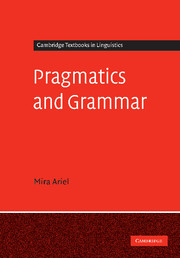Book contents
- Frontmatter
- Contents
- List of tables
- Preface
- Acknowledgments
- How to use this book
- Transcription conventions
- 1 Introduction: Grammar, pragmatics, and what's between them
- PART I Drawing the grammar/pragmatics divide
- PART II Crossing the extralinguistic/linguistic divide
- Part III Bringing grammar and pragmatics back together
- References
- Author index
- Subject index
PART II - Crossing the extralinguistic/linguistic divide
Published online by Cambridge University Press: 05 September 2012
- Frontmatter
- Contents
- List of tables
- Preface
- Acknowledgments
- How to use this book
- Transcription conventions
- 1 Introduction: Grammar, pragmatics, and what's between them
- PART I Drawing the grammar/pragmatics divide
- PART II Crossing the extralinguistic/linguistic divide
- Part III Bringing grammar and pragmatics back together
- References
- Author index
- Subject index
Summary
Introduction
Part I has emphasized that natural language understanding comprises two types of interpretations: linguistic codes and pragmatic inferences of various kinds. But, of course, we necessarily combine these two. Indeed, major points of interface between grammar and pragmatics are the ephemeral explicature and conveyed meaning, where coded and inferred meanings are integrated into the ad hoc take-home message (see chapters 1 and 7). Part II is devoted to another, very different arena for a grammar/pragmatics interface, one which has long-range effects, the emergence of grammar out of extralinguistic patterns. We here examine the possibility that grammar is often pragmatics turned code. Should we determine that this is the case (chapter 4), a set of harder questions present themselves: how does pragmatics become code? Where does this grammar/pragmatics interface take place? Does this fact undermine the grammar/pragmatics divide? (chapter 5). Part II is about grammar in the making, exemplified in detail in chapter 6. The argument is that pragmatics, together with other extragrammatical triggers, provides the raw materials and impetus for grammar.
Pragmatic inferences are not the only basis for our future grammar. Other extragrammatical patterns are too. For example, the discourse profiles discussed in section 2.3 (Preferred Argument Structure and genre-associated discourse profiles), although not necessarily inferential in nature, can potentially grammaticize. As we see below, since discourse, and more specifically the salient discourse pattern, is heavily implicated in the crossing of pragmatics into grammar, we cannot actually explain the crossing of pragmatically inferred associations into grammar without reference to the more general phenomenon of the extralinguistic crossing over to become linguistic.
- Type
- Chapter
- Information
- Pragmatics and Grammar , pp. 111 - 116Publisher: Cambridge University PressPrint publication year: 2008



